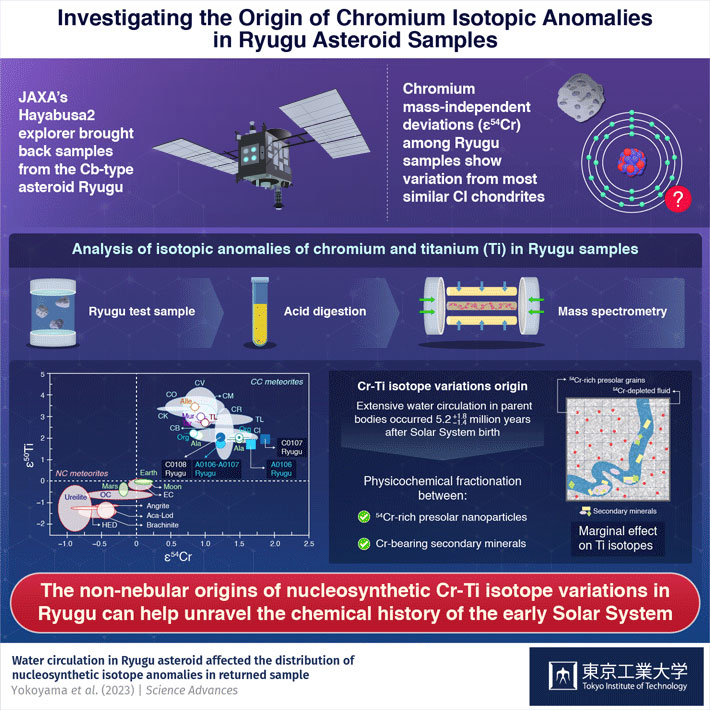The observed variations in chromium (Cr) isotope ratios in the Ryugu asteroid samples collected by Hayabusa2 likely resulted from elemental redistribution of slightly soluble Cr by water within the parent body, reveals a multinational study led by researchers from Tokyo Tech. The results provide useful insights for expanding our understanding of the origin and evolution of materials in our solar system.

Hayabusa2 space mission by the Japan Aerospace Exploration Agency (JAXA) returned home with samples of the asteroid Ryugu that orbits the Sun between Earth and Mars. Preliminary chemical analysis of Ryugu samples revealed that the asteroid is rich in volatile and organic-rich materials, which shows similarities to the class of meteorites known as Ivuna-type carbonaceous chondrites (CIs). Such asteroids have gained the attention of scientists due to their close chemical resemblance with elemental environments during the birth of the solar system.
Studies have shown that isotopic anomalies in chromium (54Cr/52Cr) and titanium ratios (50Ti/47Ti), often expressed as ε54Cr and ε50Ti, respectively, can help decipher the nucleosynthetic origins of chemical components in extraterrestrial materials. While the isotopic variability of other elements in bulk Ryugu samples is similar to that in CIs, anomalies in Cr isotopes are slightly different from those recorded in the literature. To unravel the origin of these deviations, an international team of scientists led by Professor Tetsuya Yokoyama from Tokyo Institute of Technology has recently investigated ε54Cr and ε50Ti in five different Ryugu samples. Their results have been published in Science Advances.
“Prior studies on the asteroid samples established that Ryugu and Ivuna-type carbonaceous chondrites were born in a common place; more distant part of the solar system than other meteorite parent bodies. However, the slight discrepancy in isotopic anomalies of Cr between Ryugu and CIs gave rise to the question whether the heterogeneity is due to the difference in the birth place, or did it arise from secondary processes that occurred after the accretion of their parent bodies,” explains Prof. Yokoyama.
For precise analysis of the Cr and Ti anomalies, the team selected two Ryugu samples from the first touchdown and three from the second touchdown site. The samples were first digested in acids and subjected to inductively coupled plasma mass spectrometry (ICP-MS) and thermal ionization mass spectrometry (TIMS). The test results in samples weighing less than 24 milligrams indicated that the variation in ε50Ti is marginal and agrees with the data available on CIs. The same was not true for ε54Cr values, where the dispersions exceeded formerly reported values for CIs. However, when the sample was greater than 90 milligrams, isotopic similarity was found. This observation suggested that Cr isotopes are not uniformly distributed in the Ryugu parent body at the microscopic level, while Ryugu has a Cr isotopic composition similar to CIs at the macroscopic level, thus corroborating the idea that Ryugu and CIs share a common genetic heritage.
Further analysis of the samples indicated that the microscopic heterogeneity in Cr isotope distribution arose from the physicochemical fractionation of 54Cr-rich presolar nanoparticles and Cr-bearing secondary minerals. This phenomenon was attributed to the aqueous alteration within the asteroid. The water in the asteroid dissolved the mildly soluble Cr while 54Cr-rich presolar nanoparticles undissolved, circulated the 54Cr-depleted fluid within the body, resulting in the precipitation of secondary minerals depleted in 54Cr. This scenario was supported by the analysis of radiogenic isotope 53Cr carried out by the team, which revealed that the precipitation of secondary minerals occurred around 5.2 million years after the birth of the solar system.
Nucleosynthetic 54Cr anomalies in extraterrestrial materials are often connected to their nebular origins, but this study reveals that apparent 54Cr variabilities in asteroidal materials could also rise from parent body processes such as elemental redistribution by water.
“Unlike meteorites that plummet to earth from space, Ryugu samples are unaffected by terrestrial contamination, and they are particularly valuable for unravelling the earliest history of the solar system as they retain primitive chemical characteristics. Therefore, this study is a step closer to fully understanding our chemical past,” concludes Prof. Yokoyama.
Reference
Authors : | Tetsuya Yokoyama1,* Meenakshi Wadhwa2, Tsuyoshi Iizuka3, Vinai Rai2, Ikshu Gautam1, Yuki Hibiya4, Yuki Masuda1, Makiko K. Haba1, Ryota Fukai5, Rebekah Hines2, Nicole Phelan2, Yoshinari Abe6, Jérôme Aléon7, Conel Alexander8, Sachiko Amari9, 10, Yuri Amelin11, Ken-ichi Bajo12, Martin Bizzarro13, Audrey Bouvier14, Richard W. Carlson8, Marc Chaussidon15, Byeon-Gak Choi16, Nicolas Dauphas17, Andrew M. Davis17, Tommaso Di Rocco18, Wataru Fujiya19, Hiroshi Hidaka20, Hisashi Homma21, Peter Hoppe22, Gary R. Huss23, Kiyohiro Ichida24, Trevor Ireland25, Akira Ishikawa1, Shoichi Itoh26, Noriyuki Kawasaki12, Noriko T. Kita27, Koki Kitajima27, Thorsten Kleine28, Shintaro Komatani24, Alexander N. Krot23, Ming-Chang Liu29, Kevin D. McKeegan29, Mayu Morita24, Kazuko Motomura30, Frédéric Moynier15, Izumi Nakai31, Kazuhide Nagashima23, Ann Nguyen32, Larry Nittler8, Morihiko Onose24, Andreas Pack18, Changkun Park33, Laurette Piani34, Liping Qin35, Sara Russell36, Naoya Sakamoto37, Maria Schönbächler38, Lauren Tafla29, Haolan Tang35, Kentaro Terada39, Yasuko Terada40, Tomohiro Usui5, Sohei Wada12, Richard J. Walker41, Katsuyuki Yamashita42, Qing-Zhu Yin43, Shigekazu Yoneda44, Edward D. Young29, Hiroharu Yui45, Ai-Cheng Zhang46, Tomoki Nakamura47, Hiroshi Naraoka48, Takaaki Noguchi26, Ryuji Okazaki48, Kanako Sakamoto5, Hikaru Yabuta49, Masanao Abe5, Akiko Miyazaki5, Aiko Nakato5, Masahiro Nishimura5, Tatsuaki Okada5, Toru Yada5, Kasumi Yogata5, Satoru Nakazawa5, Takanao Saiki5, Satoshi Tanaka5, Fuyuto Terui50, Yuichi Tsuda5, Sei-ichiro Watanabe20, Makoto Yoshikawa5, Shogo Tachibana51, Hisayoshi Yurimoto12 |
Title : | Water circulation in Ryugu asteroid affected the distribution of nucleosynthetic isotope anomalies in returned sample |
Journal : | Science Advances |
DOI : | |
Affiliations : | 1 Department of Earth and Planetary Sciences, Tokyo Institute of Technology, Tokyo, Japan. 2 School of Earth and Space Exploration, Arizona State University, AZ, USA. 3 Department of Earth and Planetary Science, The University of Tokyo, Tokyo, Japan. 4 Research Center for Advanced Science and Technology, The University of Tokyo, Tokyo, Japan. 5 ISAS/JSEC, JAXA, Sagamihara, Japan. 6 Graduate School of Engineering, Tokyo Denki University, Tokyo, Japan 7 Institut de Minéralogie, de Physique des Matériaux et de Cosmochimie, Sorbonne Université, Museum │į╣Ž═°šŠ d’Histoire Naturelle, Paris, France. 8 Earth and Planets Laboratory, Carnegie Institution for Science, DC, USA. 9 McDonnell Center for the Space Sciences and Physics Department, Washington University, MO, USA. 10 Geochemical Research Center, The University of Tokyo, Tokyo, Japan. 11 Guangzhou Institute of Geochemistry, Chinese Academy of Sciences, Guangzhou, China. 12 Department of Natural History Sciences, Hokkaido University, Sapporo, Japan. 13 Centre for Star and Planet Formation, GLOBE Institute, University of Copenhagen, Copenhagen, Denmark. 14 Bayerisches Geoinstitut, Universität Bayreuth, Bayreuth, Germany. 15 Université Paris Cité, Institut de physique du globe de Paris, CNRS, Paris, France. 16 Department of Earth Science Education, Seoul │į╣Ž═°šŠ University, Seoul, Republic of Korea. 17 Department of the Geophysical Sciences and Enrico Fermi Institute, The University of Chicago, Chicago, USA. 18 Faculty of Geosciences and Geography, University of Göttingen, Göttingen, Germany. 19 Faculty of Science, Ibaraki University, Mito, Japan. 20 Department of Earth and Planetary Sciences, Nagoya University, Nagoya, Japan. 21 Osaka Application Laboratory, SBUWDX, Rigaku Corporation, Osaka, Japan. 22 Max Planck Institute for Chemistry, Mainz, Germany. 23 Hawai’i Institute of Geophysics and Planetology, University of Hawai’i at Mānoa, Honolulu, USA. 24 Analytical Technology, Horiba Techno Service Co., Ltd., Kyoto, Japan. 25 School of Earth and Environmental Sciences, The University of Queensland, St Lucia, Australia. 26 Division of Earth and Planetary Sciences, Kyoto University, Kyoto, Japan. 27 Department of Geoscience, University of Wisconsin-Madison, WI, USA. 28 Max Planck Institute for Solar System Research, Göttingen, Germany. 29 Department of Earth, Planetary, and Space Sciences, UCLA, CA, USA. 30 Thermal Analysis, Rigaku Corporation, Tokyo, Japan. 31 Department of Applied Chemistry, Tokyo University of Science, Tokyo, Japan. 32 Astromaterials Research and Exploration Science, NASA Johnson Space Center, TX, USA. 33 Earth-System Sciences, Korea Polar Research Institute; Incheon, Korea. 34 Centre de Recherches Pétrographiques et Géochimiques, CNRS – Université de Lorraine, Nancy, France. 35 CAS Key Laboratory of Crust-Mantle Materials and Environments, University of Science and Technology of China, School of Earth and Space Sciences, Anhui, China. 36 Department of Earth Sciences, Natural History Museum, London, UK. 37 Isotope Imaging Laboratory, Creative Research Institution, Hokkaido University, Sapporo, Japan. 38 Institute for Geochemistry and Petrology, Department of Earth Sciences, ETH Zurich, Zurich, Switzerland. 39 Department of Earth and Space Science, Osaka University, Osaka, Japan. 40 Spectroscopy and Imaging, Japan Synchrotron Radiation Research Institute, Hyogo, Japan. 41 Department of Geology, University of Maryland, MD, USA. 42 Graduate School of Natural Science and Technology, Okayama University, Okayama, Japan. 43 Department of Earth and Planetary Sciences, University of California, CA, USA. 44 Department of Science and Engineering, │į╣Ž═°šŠ Museum of Nature and Science, Tsukuba, Japan. 45 Department of Chemistry, Tokyo University of Science, Tokyo, Japan. 46 School of Earth Sciences and Engineering, Nanjing University, Nanjing, China. 47 Department of Earth Science, Tohoku University, Sendai, Japan. 48 Department of Earth and Planetary Sciences, Kyushu University, Fukuoka, Japan. 49 Earth and Planetary Systems Science Program, Hiroshima University, Higashi-Hiroshima, Japan. 50 Kanagawa Institute of Technology, Atsugi, Japan. 51 UTokyo Organization for Planetary and Space Science, University of Tokyo, Tokyo, Japan. |







